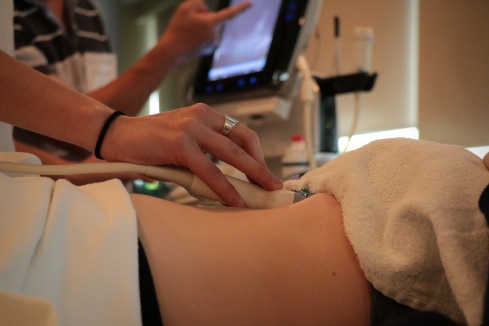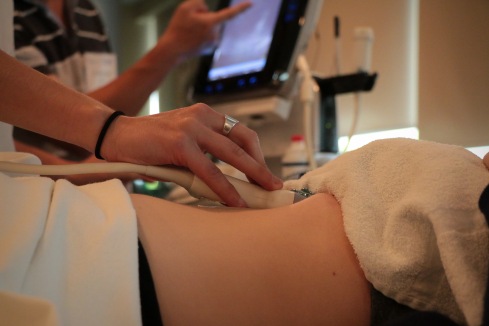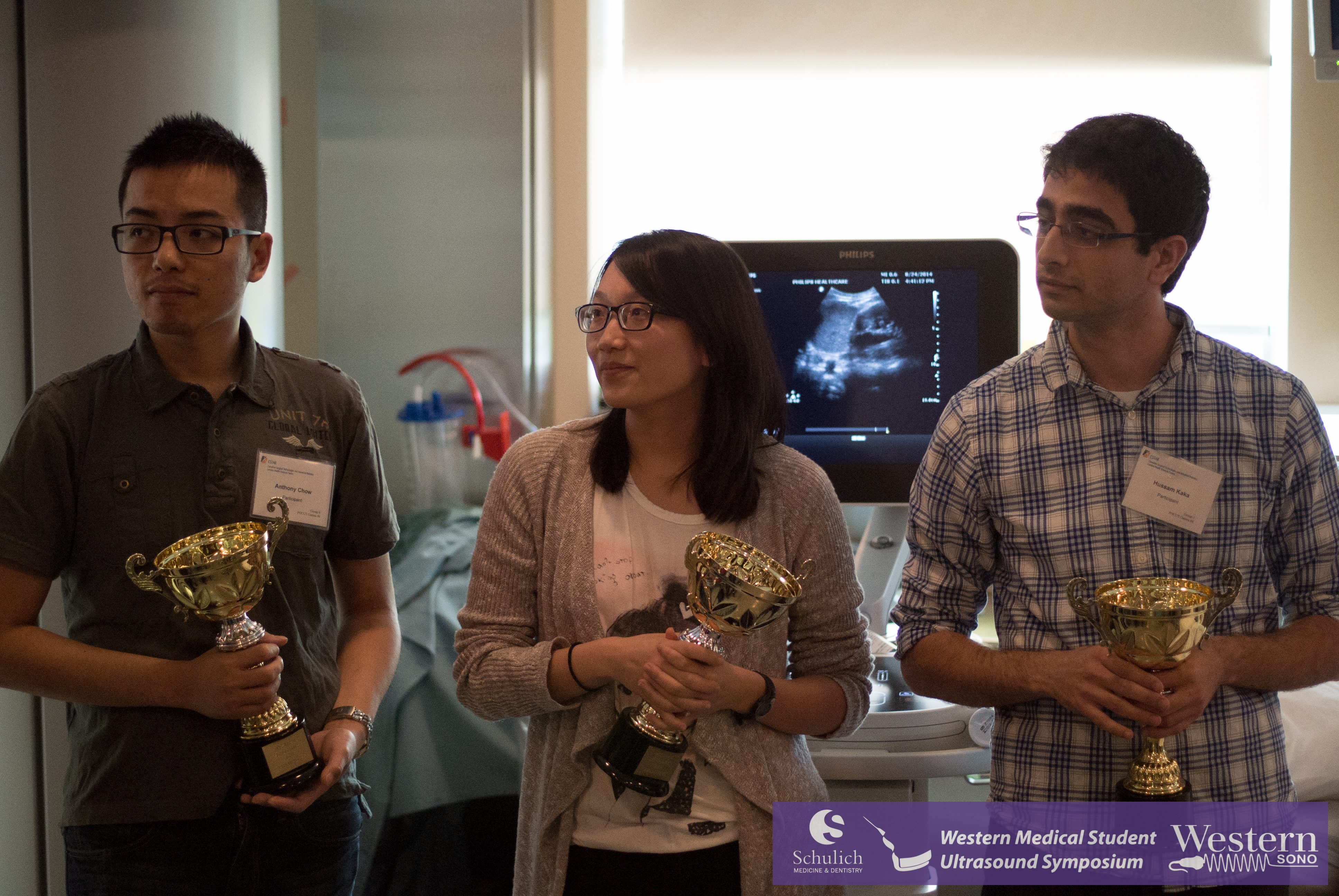The Division of Emergency Medicine is once again pleased to host its annual “Introduction to ED Point of Care Ultrasound” course on July 6th, 2017.
This course will emphasize fundamental techniques in image acquisition and interpretation and 7 indications of point of care ultrasound in the ED. Course content is aimed at practitioners who are beginning their pathway to competence in point of care ultrasound.
Topics covered will be:
- Abdominal : Presence of intra-peritoneal fluid? (Yes/No)
- Abdominal : Presence of abdominal aortic aneurysm? (Yes/No)
- Subcostal Cardiac : Presence of pericardial fluid? (Yes/No) Cardiac activity during arrest? (Yes/No)
- Pelvic : Presence of an intra-uterine pregnancy? (Yes/No)
- Thoracic: Presence of pneumothorax (Yes/No) Presence of a pleural effusion (Yes/No)
The course will feature an outstanding faculty to learner ratio for hands-on sessions as well as innovative image interpretation sessions. These small group sessions emphasize image interpretation skills and serve as intimate venues to reinforce clinical integration pathways.
Course director is Dr. Heather Hames. Bedside instructors will include faculty from within the Division of EM’s experienced group of point of care sonographers.
If you have interest in attending as a participant please contact us via email at [email protected] (please include Emergency Course in subject line).
Last years course filled up quickly so please contact us if interested.
Some pics from our previous courses can be found here.
]]>The Division of Emergency Medicine is once again pleased to host its annual “Introduction to ED Point of Care Ultrasound” course on July 6th, 2017.
This course will emphasize fundamental techniques in image acquisition and interpretation and 7 indications of point of care ultrasound in the ED. Course content is aimed at practitioners who are beginning their pathway to competence in point of care ultrasound.
Topics covered will be:
- Abdominal : Presence of intra-peritoneal fluid? (Yes/No)
- Abdominal : Presence of abdominal aortic aneurysm? (Yes/No)
- Subcostal Cardiac : Presence of pericardial fluid? (Yes/No) Cardiac activity during arrest? (Yes/No)
- Pelvic : Presence of an intra-uterine pregnancy? (Yes/No)
- Thoracic: Presence of pneumothorax (Yes/No) Presence of a pleural effusion (Yes/No)
The course will feature an outstanding faculty to learner ratio for hands-on sessions as well as innovative image interpretation sessions. These small group sessions emphasize image interpretation skills and serve as intimate venues to reinforce clinical integration pathways.
Course director is Dr. Heather Hames. Bedside instructors will include faculty from within the Division of EM’s experienced group of point of care sonographers.
If you have interest in attending as a participant please contact us via email at [email protected] (please include Emergency Course in subject line).
Last years course filled up quickly so please contact us if interested.
Some pics from our previous courses can be found here.
]]>The Division of Emergency Medicine is pleased to announce the 2015 iteration of its annual introductory course in ED point of care ultrasound. This course will emphasize the “Fundamental 4″ views and 5 indications of point of care ultrasound in the ED and is aimed at practitioners who are beginning their pathway to competence in point of care ultrasound.
The “Fundamental 4″ are:
- Abdominal : Presence of intra-peritoneal fluid? (Yes/No)
- Abdominal : Presence of abdominal aortic aneurysm? (Yes/No)
- Subcostal Cardiac : Presence of pericardial fluid? (Yes/No) Cardiac activity during arrest? (Yes/No)
- Pelvic : Presence of intra-uterine pregnancy? (Yes/No)
The course will feature an outstanding faculty to learner ratio for hands-on sessions as well as innovative image interpretation sessions. These small group sessions emphasize image interpretation skills and serve as intimate venues to reinforce clinical integration pathways.
Course directors are Drs. Behzad Hassani, Heather Hames and Grant Coome. Bedside instructors will include faculty from within the Division of EM’s experienced group of point of care sonographers.
The date for the 2015 course will be July 9, 2015. If you have interest in attending as a participant please contact us via email at [email protected] (please include Emergency Course in subject line).
Some pics from our previous courses can be found here.
**Update May1, 2015. The course is at capacity, but we are happy to keep your contact info should any spots open up. Looking forward to a great day of scanning!
]]>Hosted at the state of the art Canadian Surgical Technologies & Advanced Robotics (CSTAR) facility, this two-day symposium provided medical students with an introduction to point of care ultrasound. The event was attended by 38 medical students from 6 medical schools across Canada. Extensive opportunity for “hands-on” skill development was a focus of the symposium. This practical component was enhanced by didactic teaching from local experts. The weekend was capped off with fierce competition and a showcase of ultrasound skills as participants attempted to take home the Western SONOGames Cup!
The first day began with an electrifying keynote address by Dr. Rob Arntfield. Dr. Chris Byrne, the founder of the 1st medical student ultrasound symposium, then gave participants an informative lecture highlighting the fundamentals of ultrasound. This was followed by exciting workshops on Cardiac and Lung ultrasound led by Dr. Rob Arntfield. Dr. Drew Thompson wrapped up a busy first day by leading the FAST and Obstetrical ultrasound workshops.
Day two began with an engaging lecture by Dr. Naveen Poonai highlighting the use of ultrasound in pediatric fracture localization and reduction. Dr. Drew Thompson then led instruction in Abdominal, Aorta and Hepatobilliary ultrasound. This was followed by an expanded session on ultrasound in Procedural Guidance, taught by Drs. Vishal Uppal, Jon Brookes and Rakesh Vijayashankar. The symposium concluded with fierce but friendly competition during our Western SONOGames, which included an expanded emergency medicine simulation station (led by Drs. Ouellette and Davis). Congratulations to this year’s SONOGames winners (see photo below) for clinching a close battle and taking home the hardware. The bragging rights are all yours!
We would like to extend a special thank-you to our corporate partners SonoSite Canada, Phillips Canada, and General Electric Canada for the donation of state-of-the-art ultrasound machines. The support of ultrasound machines and expertise was invaluable! We were also fortunate to have MedaPhor graciously provide a virtual-reality training system – ScanTrainer – for medical students to explore and hone their ultrasound skills. Finally, this weekend could also not have been a success without our standardized patient models who volunteered their time to support the event.
We are excited for the new academic year and what it will bring for PoCUS and undergraduate medical education. The experiences from this past weekend demonstrate that medicals students are ready to embrace point of care ultrasound and will seek it out additional instruction independently!
Below are some photos from the weekend with credit to Weiang Yan. Also find the members of the medical student planning committee whose tireless efforts cumulated in this weekend’s symposium and the faculty and residents whose enthusiasm and expertise in teaching made the weekend a success.
Thank you to everyone for your support as we look forward to 2015 and the making of the 3rd annual Medical Student Ultrasound Symposium!
Medical Student Planning Committee: Nick Packer (2015), David Mainprize (2015), Mike Clemente (2015), Weiang Yan (2015), Ryan McLarty (2015), Evan Ailon (2016), Josh Burley (2016), Justin Cottrell (2017), Craig Olmstead (2017).
Faculty & Resident Instructors: Robert Arntfield, Drew Thompson, Su Ganapathy, Chris Byrne, Rakesh Vijayashankar, Vishal Uppal, Ramiro Arellano, Dave Ouellette, Matt Davis, Sean Doran, Alberto Goffi, Pat Murphy, Amit Shah, Jon Brookes, Naveen Poonai, Roy Roebotham and Shoeb Ashan.
]]>Several months in the making, this initiative represents a remarkable partnership between medical students, residents and faculty from a wide range of clinical departments and divisions at Western University and the Schulich School of Medicine & Dentistry. The Canadian Surgical Technologies & Advanced Robotics (CSTAR) facility and staff were extraordinary hosts for the August 24 and 25 weekend event. The Hippocratic Council at the Schulich School of Medicine and Dentistry and the Canadian Federation of Medical Students are to be graciously acknowledged for providing financial support. SonoSite Canada, Philips Canada, General Electric Canada and Siemens Canada are valued corporate partners through their generous donation of ultrasound equipment for the two-day symposium. We are grateful to Matt Dawson and Mike Mallin of the Ultrasound Podcast for recording a memorable episode of the podcast specially for the symposium and also for providing participants with the iBook version of Introduction to Bedside Ultrasound. Many thanks are also in order for the dedicated group of volunteers who acted as standardized patients throughout the weekend. Lastly, we want to recognize the passionate group of forward-thinking medical students from across Ontario who dedicated a summer weekend to participate in this innovative educational experience.
Feedback from participants, instructors and organizers alike tout the symposium as a resounding success. Beginning with Dr. Robert Arntfield’s outstanding keynote address and ending with a fierce battle for the Sono Cup (congrats to Team 5!), the symposium represented an informative and engaging educational event that has established a versatile foundation for students to build on in future training. Much data was collected over the weekend by event organizers, the results of which will be revealed in a formal study in the near future. Nonetheless, it is already apparent that participants overwhelmingly hold the view that POCUS is a motivating educational tool that compliments and enhances formal training in anatomy, physiology and clinical medicine. Organizers and instructors alike were impressed by the enthusiasm maintained by participants over the course of two eight-hour days of education, whose eyes repeatedly lit up as they witnessed anatomy and physiology come to life on the ultrasound screen.
Many professional relationships were established among participants, who are well-positioned to become POCUS student leaders at their home institutions. The local POCUS interest group at Western University looks forward to collaborating with students from the Northern Ontario School of Medicine, the University of Ottawa, Queen’s University and McMaster University who are looking to establish similar groups at their institutions. We hope the energy generated by the symposium persists well into the future. The planning committee is already looking forward to making this an annual event.
Below are some photos from the weekend. In addition, the following are the members of the medical student planning committee and the various instructors who supported the event. Thanks again for your help!
Medical Student Planning Committee: Chris Byrne (Meds 2014), Mike Clemente (Meds 2015), David Mainprize (Meds 2015), Ryan McLarty (Meds 2015), Nick Packer (Meds 2015), Sofia Nastis (Meds 2015), Weiang Yan (Meds 2015), Evan Ailon (Meds 2016), Josh Burley (Meds 2016), David Linton (Meds 2016), Angie Smith (Meds 2016)
Faculty & Resident Instructors: Robert Arntfield, Drew Thompson, Su Ganapathy, Ramiro Arellano, Dave Ouellette, Derrick Pringle, Heather Hames, Alberto Goffi, Jonathan Brookes, Raymond Kao, Ceara McNeil, Samir Raza, Kirstin Weerdenburg, Kate Hayman, Chris Lee, Matthew Slessarev, Rakesh Sondekoppam, Vishal Uppal, Brad Moffat, Pat Murphy





 ]]>
]]>


 ]]>
]]>
The value of TEE in the ICU has been well substantiated since the early 1990’s. In the post-pulmonary artery catheter era that we now find ourselves in, investment in tools that may rapidly address hemodynamic questions for those in shock is sensible. While most commonly used in the immediately post-cardiac surgery patient, we (and many groups, especially the Europeans) are finding value in the difficult to image medical patient for basic indications or in those with advanced questions. Indications for CCUS of all types are well described in this internationally endorsed consensus statement.
Ironically, in offering dedicated transthoracic echo (TTE) training to our trainees we hope to need the imaging advantage of our TEE probes relatively infrequently.
See images below to see the probe in use.
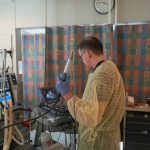
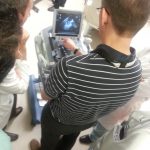
Example TEE image from our point of care machines. Note the exceptional resolution of cardiac structures in this RV inflow/outflow view was obtained at point of care for exam on septic shock in an IV drug user.
[wpvideo 6wC6ZGTG]
Next stop for TEE? The emergency department for those in cardiac arrest. Click here to learn more via a 5 minute grand rounds.
]]>See below for a 45 minute panel discussion (hosted by Matt and Mike from Ultrasound Podcast) on the topic of POC ultrasound in the assessment and management of PE. Was conducted and recorded using Google Hangout.
Panel members include luminaries of the field including:
Scott Weingart, Matt Dawson, Mike Mallin, Cliff Reid, Mike Stone
As well, Western Sono’s own Rob Arntfield was invited to join.
]]>
The Critical Care Outreach Team is called to asses a 64 year old male on the thoracic surgery floor complaining of increasing shortness of breath and hypotension. He is status post left upper lobectomy for non small cell lung cancer 1 year ago. He has been re-admitted for workup of a possible recurrence in his mediastinal nodes.
In the 24 hours prior to CCOT arrival he had become progressively acidotic and hypotensive. This was presumed to be on the basis of sepsis and appropriate treatments had been instituted. Despite this the patient remained hypotensive with BP sitting 90’s/50’s. His gases and clinical state worsened and he was taken to the ICU for further evaluation and monitoring.


As is routine for patients admitted to our ICU’s with circulatory failure, a point of care echocardiogram was performed on arrival to the ICU:
Subcostal 4 Chamber
[youtube http://www.youtube.com/watch?v=M9s-KxcycK8?rel=0]
Parasternal Short Axis
[youtube http://www.youtube.com/watch?v=q8YUn6-mR9Q?rel=0]
Apical 4 Chamber
[youtube http://www.youtube.com/watch?v=QWtaWGdMZdA?rel=0]
What is your impression of the images? Is there any significant abnormalities seen? Click HERE for the answers and discussion and to learn the outcome of the case.
]]>[youtube=http://www.youtube.com/watch?v=GSp_xyWBKK0&w=420&h=315]
]]>